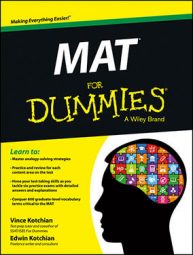To do well on the MAT, you have to know common musical terms and their meanings. This list will keep you in tune with the musical terms you need to know to succeed on the Miller Analogies Test.
A cappella: Style of singing without any instruments accompanying the voice(s)
Accelerando: Gradually speeding up
Accent: Marking placed on a note to indicate significance
Adagio: Slow speed for a song
Allegretto: Moderately fast speed for a song
Allegro: Fast speed for a song
Altissimo: Very high range of notes
Alto: Lowest boy’s/woman’s vocal range
Andante: Relaxed speed for a song, like walking
Appoggiatura: Grace notes that take some of the following note’s duration
Arpeggio: Notes of a chord played individually
A tempo: Indicates a return to the original speed of a song
Bass: Lowest male vocal range (or) tones of low frequency. Opposite of treble
Beat: Continued rhythm of a song
Bend: Sliding a note up or down a little in jazz
Brass: Instruments like trumpets, tubas, and trombones
Bridge: Section of a song that differs from the refrain or verse
Cadenza: Solo section of a song
Canon: Musical theme that is repeated and layered
Carol: A festive, usually religious song
Chord: Group of notes played simultaneously
Clef: Symbol on the staff to define note range (for example, G clef, bass clef)
Coda: Final section of a song
Coloratura: Ornamentation of a vocal part
Contralto: Lowest female vocal range
Countertenor: Highest male vocal range
Crescendo: Gradually increasing the volume
Decelerando: Gradually slowing down
Decrescendo: Gradually decreasing the volume
Dirge: A song expressing grief; commonly heard at funerals
Dynamics: Indications of volume in a song
Encore: Another song played at the end of a concert by request
Falsetto: Vocal range above the normal, especially in men
Fermata: Marking to indicate holding a note longer than usual
Fine: The end
Flat: Marking indicating that a note should be lowered by one tone
Forte: Loud
Fortissimo: Very loud
Harmony: The use of multiple notes simultaneously to create chords
Hymn: Song praising a deity
Intro: Beginning of a song
Key: One of the 12 notes that a song can be based on
Largo: Slowly
Legato: Smoothly, connected
Marcato: Every note accented
Measure: Short unit of a song comprising a cycle of beats
Medley: Song made up of parts of other songs
Melisma: Changing the note during one syllable
Meter: The rhythmic beat of a song
Metronome: Timekeeping device that produces regular beats
Mezzo-forte: Moderately loud
Mezzo-piano: Moderately soft
Motif: A short musical idea that repeats itself in songs
Natural: Marking that cancels an existing sharp or flat
Octave: The eight notes comprising a scale
Oratorio: Large musical composition, like an opera
Percussion: Instruments that are struck like drums or bells
Pianissimo: Very soft
Piano: Soft
Pitch: The ordering of musical tones based on frequency
Poco: A little
Prelude: Musical introduction
Presto: Quickly
Rest: A period of silence in a song
Ritard: Slowing down
Rondo: A form of a song where the theme is alternated between other sections
Rubato: Flexible speed, not like a metronome
Scale: A sequence of notes all either ascending or descending
Semitone: Half-step. The smallest interval between notes
Sforzando: Suddenly loud and accented
Sharp: Marking indicating that a note should be raised by one tone
Soprano: Highest female vocal range
Staccato: Making each note very short
Staff: The five lines on which notes are placed
Subito: Suddenly
Syncopation: Style with emphasis on the upbeats
Tacet: Silent
Tempo: Speed of a song
Tenor: High male vocal range
Tenuto: Marking that indicates holding a note slightly longer
Tessitura: Middle or most comfortable part of a note range
Treble: Tones of high frequency; Opposite of bass
Trill: Quickly alternating between two notes
Tutti: All
Vibrato: Note wavering up and down
Woodwinds: Instruments including flutes, oboes, and saxophones

